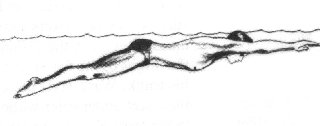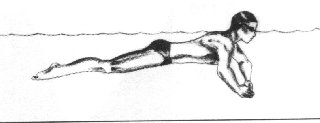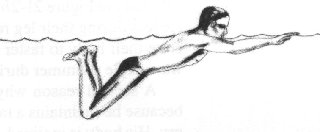The Modern Breaststroke
There are three different styles of breaststroke being swum today; the wave style, the flat or conventional style and the undulating style. In the seven years that the wave style has been possible I have only seen less than a dozen masters swim it correctly. The undulating style is primarily swum by young extremely flexible girls. Very few masters women or men retain the extreme flexibility to do this style. I really cannot recommend this style for masters, primarily because this style does not take advantage of the rules that allow you to put your head underwater. What I do recommend is a modified flat or modified wave style, using the wave's base position as the starting point. This base position is with the body flat in the water, streamlined. The head is between the arms, starting to go underwater with the back above the waters surface. The back is out of the water to eliminate lifting water up with each stroke, one of the disadvantages of the undulating style.

In the wave style the arms and upper body are thrown forward over the water into the base position, after each pull. In both the modified wave and the flat style the arms are pushed forward through the water and into the base position. There is less resistance with your body underwater than when you kick with the body at the surface. Both the wave and flat styles of breaststroke benefit by putting your head and body underwater at the start of each kick. From US Masters Rule Book Some part of the swimmers head shall break the surface of the water at least once during each complete cycle of one armstroke and one leg kick. Article 101.2.2. This rule allows you to kick with your head underwater, reducing resistance. Your head will break the waters surface when you breathe at the end of the insweep of each stroke, satisfying the rule. The best way to learn breaststroke is to think there is no pull back in the modern breaststroke! The arms shall move simultaneously and in the same horizontal plane without any alternating movement. Article 101.2.2. US Rule Book. There is simply a scull out and a scull inward to just under the face.
We start by learning the shoulder shrug, shrugging the shoulders up, the elbows out, and the palms of the hands facing outward. The shoulder shrug puts your shoulders and arms in the same position as a butterflyers when their arms are recovered forward. This is the ideal way to begin the out-scull as the shoulders are narrower during the shrug, reducing resistance. The shrug makes it difficult to drop the elbows, a major stroke problem. It also uses the pectoral and lattissimus muscles more, taking advantage of these large muscles.

The out-scull is not very propulsive, to get any propulsion you must pitch the hands at an angle to the fore-arms, thirty to forty-five degrees. The hands should be about six inches under the water's surface when beginning the out-scull. Your hands should move out and slightly upwards so that your hands are just under the water's surface at the catch point, slightly past your shoulders width. How wide you make the catch point depends on how strong you are. At the catch the palms are changed from out and back to down and back. This down sweep begins the powerful insweep.

The insweep is the propulsive portion of the arm movement. With the shoulders shrugged up the hands are accelerated first down and then inwards until the palms come together under the chin. The insweep ends with the hands moving up and forward together.

During this powerful insweep you should breathe with your head looking downwards or slightly forward. The hands shall be pushed forward together from the breast on, under, or over the surface of the water Article 101.2.2. This is called the arm recovery and should be done by squeezing the elbows together in front of the chest, with the palms together.

If the elbows are not squeezed in front of the chest they can combine with the arms and chest as one massive resistance to the water. The elbows coming together forces the hands to move quickly from the insweep to the recovery; many breaststrokers have a problem with pausing at that point.

When the hands are nearly extended, shrug the shoulders to begin the outscull.

The easiest way to learn the out-scull and insweep is to swim one lap of breast, starting with the hands fully extended. Scull out about ten inches and scull in with the hands until they clap together. Then swim another lap sculling out to about twelve inches, emphasizing the insweep. Now swim another lap, sculling out to where it feels comfortable, emphasizing the power of the insweep.
Drills for the arms:
- Pull while kicking dolphin or flutter kick. Think quick hands, but without slipping the water. The easiest way to increase arm force is to increase your hand speed.
- Pull with a pull-buoy as different muscles are worked. Pull 200-300 yards at a time to really feel the forearm pain. Breaststrokers must pull often in practice, while others are pulling freestyle. Because we rely so much on the kick, breaststrokers must work more on our pull to improve our weak spot
.
Ask any breaststroker the secret of the stroke and they will say the kick! All vertical and lateral movements of the legs shall be simultaneous. The feet must be turned outward during the propulsive part of the kick movement. A scissors, flutter, or downward butterfly kick is not permitted. Article 101.2.3. The kick can be easily learned by standing up on land. Pull one of your feet up to your rear, and turn the foot outwards away from the body. Now just straighten the leg! Turn the sole of the foot inwards so that when it reaches the floor the sole of the foot is facing inwards and parallel to the floor. The most important idea in the kick is to finish with the toes pointing to the bottom of the pool and the soles of the feet coming together. The feet are also kicked downwards from the water's surface, not straight back. If you kick as described and press downwards with the chest, the hips will rise, just like a butterflyers hip motion. With your hips high in the water you can recover the legs back up to the buttocks with the knees causing much less resistance to the water. Accelerate the feet until your soles and ankles smack together.
Kicking Drills:
- Kick without a board, one kick with your head and body underwater, one kick with a breath.
- Kick without a board, two kicks with your head and body underwater, one kick with a breath.
- Forward Egg-beater; the muscles that get the most tired during a race are not the kicking muscles but the muscles that pull the legs up to the buttocks. The best exercise for these muscles is the waterpolo egg-beater drill, which is kicking one leg straight back and then the other leg. Kick down the pool pumping the legs as fast as you can. This will not only strengthen the muscles it will increase leg speed. If you want to go faster you must increase the force applied to the water. Since force is strength times speed, it is easier to increase leg speed that leg power.
- Kick on your back, watching to see if the knees break the water surface. Try to bring the feet back to the buttocks without breaking the surface with the knees.
The key to a powerful breaststroke is the timing you use. There are three patterns in use; glide, continuous, and overlap timing.
- Glide timing has a small pause when the hands are fully extended.
- Continuous timing has no pause, and is not recommended because the out scull is not very propulsive, causing a drop in speed right when speed is the highest; after the kick.
- Overlap timing is used by most fast breaststrokers to reduce the period of slowing down from the kick and the insweep of the arms. This timing is done by sweeping the arms for the out scull while the legs are coming together at the finish of the kick.
You should increase the overlap if your insweep is less powerful. This results in a rapid turnover and greater energy cost, but is faster.
Wayne McCauley has been masters All-American several times, in the 50 and 200 breaststroke events, as well as national champion in the 50 breast. Wayne competes annually in over 25 masters meets, including Glasgow Scotland and Paris, France.
Categories:
- Technique and Training
SIGN UP FOR UPDATES FROM USMS














